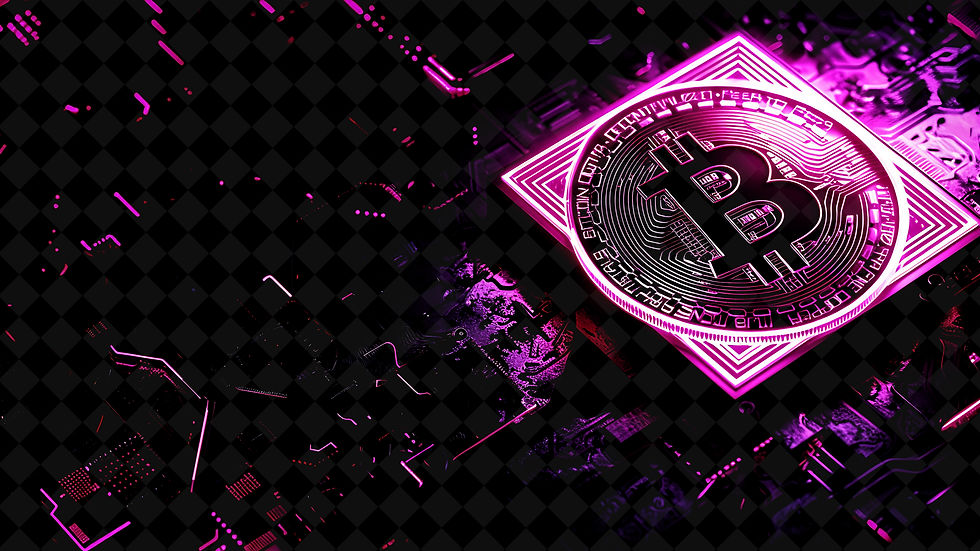Decentralized Finance (DeFi): A New Way to Manage Your Money Without Banks
- Irina Maryanchik

- Jun 6
- 7 min read

What is Decentralized Finance?
Imagine if you could earn interest on your savings, get loans, or make investments without ever walking into a bank or dealing with lengthy paperwork. That's essentially what Decentralized Finance, or "DeFi," offers. It's a new financial system built on the internet that operates without traditional banks, brokers, or other financial middlemen.
Think of DeFi like a farmers' market compared to a large grocery store chain. At a farmers' market, you deal directly with the person who grew your vegetables, cutting out the corporate middleman. Similarly, DeFi lets you handle financial transactions directly with other people through secure computer programs, eliminating the need for banks as intermediaries.
The "decentralized" part means no single company or institution controls the system. Instead, it runs on a network of computers worldwide, much like how email works across the internet without being owned by any one company. This system uses cryptocurrency (digital money) and operates on what's called a "blockchain" - essentially a secure, transparent digital ledger that everyone can verify but no one can manipulate.
Traditional Banking vs. DeFi: A Side-by-Side Comparison
Getting a Loan: Traditional vs. DeFi
Traditional Banking: You visit a bank, fill out extensive paperwork, wait for credit checks, provide income verification, and hope for approval after days or weeks. If approved, you might pay 6-18% interest depending on the loan type and your credit score.
DeFi: You connect to a DeFi platform, put up cryptocurrency as collateral (similar to pawning an item), and receive a loan instantly. The interest rate is determined by market supply and demand, often resulting in more competitive rates. The entire process takes minutes, not days.
Earning Interest on Savings
Traditional Banking: Your savings account earns perhaps 0.5% annual interest while the bank lends your money out at much higher rates, keeping the difference as profit.
DeFi: You can earn 3-12% annual interest by lending your cryptocurrency directly to borrowers through DeFi platforms. You receive most of the interest because there's no bank taking a large cut.
Real-World DeFi Applications That Could Benefit You
Enhanced Savings and Investment Returns
The Problem: Traditional savings accounts offer minimal returns that don't keep pace with inflation. CDs lock up your money for low returns.
The DeFi Solution: Yield farming and liquidity pools allow you to earn significantly higher returns on your money. Think of it like being the bank yourself - you lend money directly to borrowers and keep the interest that normally goes to the bank.
Real Example: Susan, a 58-year-old from Ohio, moved $50,000 from her savings account earning 0.4% to a DeFi platform earning 8% annually. This increased her annual income from $200 to $4,000 - enough to cover her monthly grocery bills.
Accessible Credit Without Traditional Requirements
The Problem: Getting approved for loans becomes more difficult as you approach or enter retirement, especially with variable income.
The DeFi Solution: Collateral-based lending allows you to borrow against assets you already own (like cryptocurrency or tokenized real estate) without credit checks or income verification.
Real Example: Bob, 62, needed $30,000 for home repairs but was denied a traditional loan due to his part-time retirement income. Using DeFi, he borrowed against his cryptocurrency holdings at a competitive rate without paperwork or waiting periods.
Global Investment Opportunities
The Problem: Accessing international investments traditionally requires expensive brokers and high minimum investments.
The DeFi Solution: DeFi platforms provide access to global investment opportunities with low fees and no minimum requirements. You can invest in foreign markets, currencies, or unique assets previously available only to wealthy investors.
Transparent and Programmable Financial Services
The Problem: Traditional financial products often have hidden fees, complex terms, and opaque pricing.
The DeFi Solution: All DeFi transactions and rules are publicly visible and automatically executed by computer code (called "smart contracts"). There are no hidden fees or mysterious terms - everything is transparent and predictable.
Specific DeFi Platforms and Their Real-World Benefits
Compound: The Digital Savings Account
Compound allows you to lend your cryptocurrency and earn interest that compounds automatically. Unlike traditional CDs, you can withdraw your money anytime without penalties. Current rates often exceed 5-10% annually, far better than traditional savings.
Uniswap: The People's Stock Exchange
Uniswap lets you trade different cryptocurrencies without going through a traditional exchange. Think of it as a 24/7 global marketplace where you can exchange one type of digital asset for another, often with better rates than traditional currency exchanges.
MakerDAO: Your Personal Bank
MakerDAO allows you to create loans by using your cryptocurrency as collateral. It's like having a home equity line of credit, but using digital assets instead of your house as collateral.
Aave: The Flexible Lender
Aave offers both standard loans and "flash loans" - unique financial instruments that don't exist in traditional banking. You can also earn interest by depositing funds that others borrow.
Advantages Over Traditional Finance
Lower Fees
Traditional banks charge fees for almost everything: account maintenance, wire transfers, overdrafts, and loan origination. DeFi platforms typically charge only small transaction fees (usually $5-20), with no monthly maintenance charges or hidden costs.
24/7 Accessibility
Banks have business hours; DeFi operates continuously. You can access your money, make investments, or conduct transactions anytime, anywhere in the world. This is particularly valuable for urgent financial needs or international transactions.
Higher Returns
Because DeFi eliminates expensive infrastructure (bank branches, employees, executive salaries), more of the profits can go to users. This results in higher interest rates for savers and often lower rates for borrowers.
Transparency and Control
Every DeFi transaction is recorded on a public blockchain. You can verify exactly what happened to your money, how fees are calculated, and how the system operates. This level of transparency is impossible with traditional banking.
Global Access
DeFi platforms are accessible from anywhere with internet access. This is particularly valuable for international travelers or people who split time between different countries.
Addressing Common Concerns
"Is It Safe?"
DeFi platforms use the same security technology that protects military communications and major corporations. However, like any investment, there are risks. The key is starting small, using established platforms, and never investing more than you can afford to lose.
Many DeFi platforms now carry insurance through companies like Nexus Mutual, providing additional protection for users' funds.
"It Seems Too Complicated"
While the underlying technology is complex, using DeFi can be as simple as using an ATM. Modern DeFi platforms have user-friendly interfaces similar to online banking. Companies like Coinbase and other established financial institutions now offer simplified DeFi access.
"What About Taxes?"
DeFi transactions are taxable events, just like traditional investments. However, the transparent nature of blockchain records actually makes tax reporting easier in many cases. Several companies now offer DeFi tax reporting services to simplify this process.
"Why Haven't I Heard About This?"
DeFi is relatively new (most platforms launched after 2018), and traditional financial institutions have little incentive to promote alternatives to their services. However, major companies like JPMorgan, Goldman Sachs, and PayPal are now integrating DeFi services, indicating mainstream acceptance.
Getting Started Safely
Start with Established Platforms
Begin with well-known, audited platforms like Compound, Aave, or Uniswap. These have track records and security audits from reputable firms.
Use Dollar-Backed Cryptocurrencies
Start with "stablecoins" like USDC or DAI, which are designed to maintain the same value as the US dollar. This eliminates the volatility concern while you learn the system.
Begin Small
Start with an amount equivalent to what you might put in a new savings account - perhaps $1,000-5,000. This allows you to learn without significant risk.
Educate Yourself
Take advantage of educational resources from established platforms. Many offer tutorials, webinars, and customer support specifically designed for newcomers.
Consider Professional Guidance
Some financial advisors now specialize in DeFi integration. They can help you understand how DeFi fits into your overall retirement and investment strategy.
Real-Life Client Success Stories
Maria, 59, from California: "I was frustrated earning 0.3% on my emergency fund. I moved half to a DeFi platform earning 6%. In one year, I earned more interest than the previous ten years combined in traditional savings."
David, 61, from Florida: "When my financial advisor quoted me 12% for a business loan, I used DeFi instead and got 7%. The same day approval meant I could close on a property investment immediately."
Patricia, 55, from New York: "I wanted to diversify beyond US stocks but couldn't meet the minimums for international funds. Through DeFi, I'm now investing globally with amounts as small as $100."
The Future of DeFi
Major financial institutions are increasingly adopting DeFi technology. JPMorgan has launched blockchain-based payment systems, while Goldman Sachs offers cryptocurrency custody services. This institutional adoption suggests DeFi will become more mainstream and regulated, potentially making it safer and more accessible for everyday users.
The technology is also becoming more user-friendly. New platforms offer interfaces that look and feel like traditional online banking, making the transition smoother for people comfortable with existing technology.
Conclusion: Taking the Next Step
DeFi represents a significant evolution in financial services, offering real benefits like higher returns, lower fees, and greater control over your money. While it requires some learning, so did online banking, ATMs, and smartphone apps when they first appeared.
The key is approaching DeFi thoughtfully: start small, use established platforms, and view it as a complement to, not a replacement for, your existing financial strategy. Consider working with a financial advisor familiar with DeFi to ensure it fits appropriately into your overall financial plan.
As you approach or navigate retirement, every dollar counts. DeFi offers tools that can potentially improve your financial situation significantly - higher returns on savings, access to credit, and reduced fees. By taking time to understand and carefully experiment with DeFi, you may discover financial opportunities that weren't available through traditional banking.
Remember, you don't need to become a technology expert to benefit from DeFi, any more than you needed to understand telephone networks to make phone calls. The focus should be on understanding how these tools can solve real financial problems and improve your quality of life.






Comments